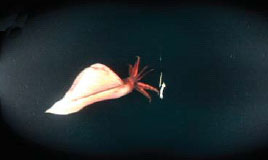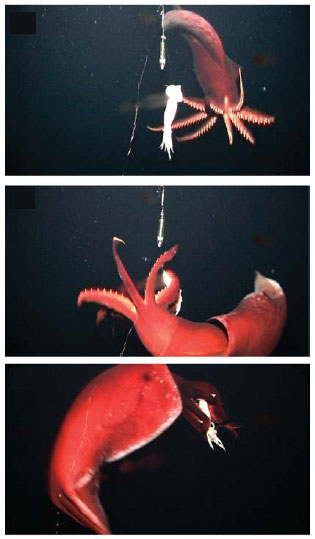Giant squid use bioluminescence to hunt prey, communicate
Giant squid use bioluminescence to hunt prey, communicate
mongabay.com
February 23, 2007
The giant squid uses bioluminescence to hunt its prey, according to new deap-sea observations using a high definition underwater video camera system. The findings are published in the online edition of the Proceedings of the Royal Society B.
Last year Japanese researchers caused a sensation when they captured the first video of a live giant squid off the Ogasawara Islands, western North Pacific. At the time little was known about the elusive beast.
Now the scientists have published their findings which show that giant squid (Taningia danae) are highly active predators that use blinding light flashes to confuse their prey.

Video capture of the giant squid feeding. Images courtesy of Proceedings of the Royal Society B. |
The authors — Tsunemi Kubodera of Tokyo’s National Science Museum, Yasuhiro Koyama of the Japan Broadcasting Corporation, and Kyoichi Mori of the Ogasawara Whale Watching Association — report that giant squid generally stay at a depth of 600-900 meters during the day but ascend to shallower depths at night to hunt their prey, which consists of fish and smaller squid. Squid were found to be aggressive attackers that use their large triangular fins to maneuver quickly both backwards and forwards.

Video capture of the giant squid feeding. Images courtesy of Proceedings of the Royal Society B. |
The authors observed frequent discharge of bioluminescent light flashes which they believe are used by the squid for hunting and communication with other squid.
“This emission may work as a blinding flash for the prey, as well as a means of illumination and measuring target distance in an otherwise dark environment,” write the authors, referring to short bursts of light observed when squid were hunting.
“The most interesting bioluminescence observed was a long glow when approaching (4.4—8.5 s) and several short glows separated by intervals when wandering around the bait without attacking. We believe that this behaviour may represent attempts at communication with conspecifics using bioluminescence,” the add.
The researchers used a bait ring, underwater lights, and a video camera to make their observations. They found that “blue light seemed provocative” for squid.
“Attacking to the blue-filtered halogen light might be an aggressive behaviour against potential adversaries,” they noted.
The paper was published at the same time that fishermen from New Zealand reported the first ever capture of the colossal squid, a species larger, and even more mysterious than the giant squid.